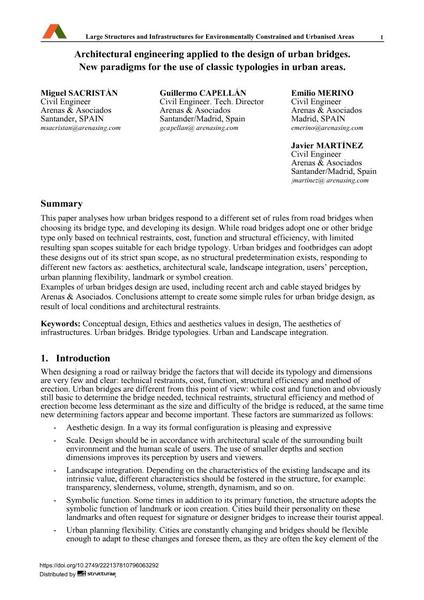Architectural engineering applied to the design of urban bridges
New Paradigm for the Use of Classic Typologies in Urban Areas

|
|
|||||||||||
Bibliographic Details
| Author(s): |
Miguel Sacristán
Guillermo Capellán Emilio Merino Javier Martínez |
||||
|---|---|---|---|---|---|
| Medium: | conference paper | ||||
| Language(s): | English | ||||
| Conference: | IABSE Symposium: Large Structures and Infrastructures for Environmentally Constrained and Urbanised Areas, Venice, Italy, 22-24 September 2010 | ||||
| Published in: | IABSE Symposium Venice 2010 | ||||
|
|||||
| Page(s): | 672-673 | ||||
| Total no. of pages: | 8 | ||||
| Year: | 2010 | ||||
| DOI: | 10.2749/222137810796063292 | ||||
| Abstract: |
This paper analyses how urban bridges respond to a different set of rules from road bridges when choosing its bridge type, and developing its design. While road bridges adopt one or other bridge type only based on technical restraints, cost, function and structural efficiency, with limited resulting span scopes suitable for each bridge typology. Urban bridges and footbridges can adopt these designs out of its strict span scope, as no structural predetermination exists, responding to different new factors as: aesthetics, architectural scale, landscape integration, users’ perception, urban planning flexibility, landmark or symbol creation. Examples of urban bridges design are used, including recent arch and cable stayed bridges by Arenas & Asociados. Conclusions attempt to create some simple rules for urban bridge design, as result of local conditions and architectural restraints. |
||||
| Keywords: |
conceptual design urban bridges the aesthetics of infrastructures Ethics and aesthetics values in design Bridge typologies Urban and Landscape integration
|
||||
